- Astacus astacus
-
Astacus astacus Conservation status Scientific classification Kingdom: Animalia Phylum: Arthropoda Subphylum: Crustacea Class: Malacostraca Order: Decapoda Family: Astacidae Genus: Astacus Species: A. astacus Binomial name Astacus astacus
(Linnaeus, 1758)Synonyms Astacus fluviatilis Fabricius, 1775
Astacus astacus, the European crayfish, noble crayfish or broad-fingered crayfish, is the most common species of crayfish in Europe, and a traditional foodstuff. Like other crayfish, Astacus astacus is restricted to fresh water, living only in unpolluted streams, rivers and lakes. It is found from France throughout Central Europe, to the Balkan peninsula, and north as far as parts of the British Isles, Scandinavia, and the western parts of the former Soviet Union. Males may grow up to 16 cm long, and females up to 12 cm.[2]
Contents
Ecology
A. astacus is nocturnal and feeds on worms, aquatic insects, molluscs and plants, spending the day resting in a burrow. They become sexually mature after three to four years and a series of moults, and breed in October and November. Fertilised eggs are carried by the female, attached to her pleopods, until the following May, when they hatch and disperse. The main predators of A. astacus, both as juveniles and adults, are mink, eels, perch, pike, otters, and muskrats.[2]
Consumption
 Noble crayfish vary greatly in colour.[3]
Noble crayfish vary greatly in colour.[3]
Astacus astacus was once abundant in Europe, although it was expensive to buy, and is considered to be the finest edible crayfish.[2] It is, however, susceptible to the crayfish plague carried by the invasive American species signal crayfish (Pacifastacus leniusculus), and is therefore listed as a vulnerable species on the IUCN Red List.[1]
Documentation of the consumption of A. astacus dates back to the Middle Ages, when it was popular among the Swedish nobility, spreading to all social classes by the 17th and 18th centuries due to its ready availability. The crayfish are collected from the wild in traps, a practice which is being replaced by more intensive aquaculture of the signal crayfish in man-made ponds.[4] The consumption of crayfish is an important part of traditional Scandinavian culture, including the crayfish party or kräftskiva, a feast to mark the end of summer.[4]
Astacin
Astacins are a family of digestive enzymes, discovered in the 1990s, which were first isolated from Astacus astacus. More than 20 enzymes of this group have since been discovered in animals from Hydra to humans.[5]
References
External identifiers for Astacus astacus EOL 1021866 ITIS 97333 NCBI 6715 Also found in: Wikispecies, ARKive - ^ a b "Astacus astacus". IUCN Red List of Threatened Species. Version 2010.4. International Union for Conservation of Nature. 2010. http://www.iucnredlist.org/apps/redlist/details/2191. Retrieved 31 March 2011.
- ^ a b c "Noble crayfish (Astacus astacus)". ARKive. http://www.arkive.org/species/GES/invertebrates_terrestrial_and_freshwater/Astacus_astacus/more_info.html. Retrieved May 6, 2007.
- ^ Peter Scheffel & Bernd Sceiba. Plants and Animals of Central Europe (Pflanzen und Tiere).
- ^ a b "Astacus astacus". Slow Food Foundation. http://www.slowfoodfoundation.com/eng/arca/dettaglio.lasso?cod=628&prs=0.
- ^ J. S. Bond & R. J. Benyon (1995). "The astacin family of metalloendopeptidases" (abstract). Protein Science 4 (7): 1247–1261. doi:10.1002/pro.5560040701. PMC 2143163. PMID 7670368. http://www.proteinscience.org/cgi/content/abstract/4/7/1247.
Categories:- IUCN Red List vulnerable species
- Astacidae
- Freshwater crustaceans of Europe
- Commercial crustaceans
- Edible crustaceans
- Animals described in 1758
- Ark of Taste foods
Wikimedia Foundation. 2010.


